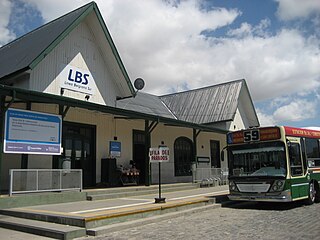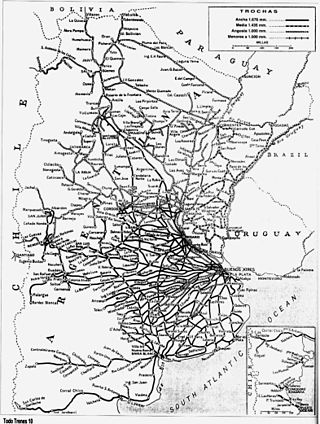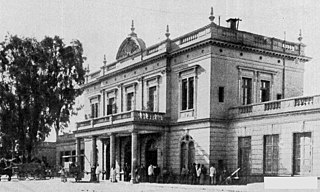
Transport in Argentina is mainly based on a complex network of routes, crossed by relatively inexpensive long-distance buses and by cargo trucks. The country also has a number of national and international airports. The importance of the long-distance train is minor today, though in the past it was widely used and is now regaining momentum after the re-nationalisation of the country's commuter and freight networks. Fluvial transport is mostly used for cargo.

Comodoro Rivadavia, often shortened to Comodoro, is a city in the Patagonian province of Chubut in southern Argentina, located on the San Jorge Gulf, an inlet of the Atlantic Ocean, at the foot of the Chenque Hill. Comodoro Rivadavia is the most important city of the San Jorge Basin, and is the largest city in Chubut as well as the largest city south of the southern 45th parallel.

Buenos Aires is a former passenger railway station in the city of Buenos Aires, Argentina. The station was terminus of the Belgrano Sur line that runs trains along Greater Buenos Aires region.

Ferrovías S.A.C. is a privately owned company which, on 1 April 1994, took over the concession, granted by the Argentine government as part of railway privatisation during the presidency of Carlos Menem, for the operation of the 1,000 mm Belgrano Norte Line commuter rail service in Buenos Aires, Argentina.

Estadio Municipal de Comodoro Rivadavia (also named Estadio Km. 3 is a football stadium located in the city of Comodoro Rivadavia in the Chubut Province of Argentina. It is owned by the local Municipality and was opened in 1975. The stadium has a capacity of 8,300 spectators, and was refurbished to built press booths.

The General Roca Railway (FCGR) is a 5 ft 6 in broad gauge railway in Argentina which runs from Constitución station in Buenos Aires to the south of the country through the provinces of Buenos Aires, La Pampa, Neuquén and Río Negro. It was also one of the six state-owned Argentine railway divisions formed after President Juan Perón's nationalisation of the railway network in 1948, being named after former president Julio Argentino Roca. The six companies were managed by Ferrocarriles Argentinos which was later broken up during the process of railway privatisation beginning in 1991 during Carlos Menem's presidency.

The Central Chubut Railway was a British-owned company that built and operated a 1,000 mmmetre gauge railway line in the Argentine province of Chubut in the Patagonia region at the end of the 19th. century.

Rada Tilly is a town in Escalante Department, Chubut Province (Patagonia), Argentina. The town is between Punta Piedras hill to the north and Punta del Marqués to the south. Punta del Marqués, a geographical landmark on San Jorge Gulf, reaches a height of 167 metres (548 ft), and extends into the sea for 1.5 kilometres (0.93 mi).

Ferrocarriles Patagónicos was an Argentine State-owned railway company that built and operated several rail lines in Patagonia region. FP were part of the Argentine State Railway created in 1909 during the presidency of José Figueroa Alcorta.

The Sarmiento line is a broad gauge commuter rail service in Buenos Aires Province, Argentina, run by the state-owned Trenes Argentinos since 11 September 2013.

The Roca line is a 1,676 mm gauge commuter rail service in the Buenos Aires Province, Argentina, part of General Roca Railway network. The service is currently operated by State-owned company Trenes Argentinos, from the city-centre terminus of Constitución south to Ezeiza, Alejandro Korn, La Plata, Cañuelas, Chascomús, Gutiérrez and Lobos, and west to Sarmiento Line's station Haedo. The transfer stations between the branch lines are Avellaneda, Temperley, Bosques and Berazategui.

Railway privatisation in Argentina was a process which began in 1989 under the presidency of Carlos Menem, following a series of neoliberal economic reforms. This primarily consisted of breaking up the state-owned railway company Ferrocarriles Argentinos (FA) and allowing the former lines to be operated by private companies instead of the state.

The Argentine railway network consisted of a 47,000 km (29,204 mi) network at the end of the Second World War and was, in its time, one of the most extensive and prosperous in the world. However, with the increase in highway construction, there followed a sharp decline in railway profitability, leading to the break-up in 1993 of Ferrocarriles Argentinos (FA), the state railroad corporation. During the period following privatisation, private and provincial railway companies were created and resurrected some of the major passenger routes that FA once operated.

Sol Líneas Aéreas Flight 5428 was a passenger flight which crashed near Los Menucos, Argentina, on 18 May 2011, killing all 22 people on board. The aircraft involved, a Saab 340, was operating Sol Líneas Aéreas' scheduled domestic service from Neuquén to Comodoro Rivadavia.

Corredores Ferroviarios was an Argentine private company that operated the Mitre and San Martín railway services in Buenos Aires Province for about one year until the Government of Argentina rescinded the agreement with the company in March 2015. Since then, the Mitre and San Martín line are operated by State-owned company Operadora Ferroviaria Sociedad del Estado (SOFSE).

The Comodoro Rivadavia and Colonia Sarmiento Railway was an Argentine railway company that built and operated a broad gauge line that connected the port of Comodoro Rivadavia with Colonia Sarmiento in Chubut Province. The FCCRCS -belonging to Argentine State Railway- also connected to Central Chubut Railway.

The Puerto Deseado and Colonia Las Heras Railway was a State-owned railway company that ran between the cities of Puerto Deseado to Colonia Las Heras in Santa Cruz Province. The 283-km broad gauge railway was established with the intention of encouraging settlement in Patagonia, which was sparsely populated at that point. The railway also contributed to the commercialisation of wool in the region.

Santa Fe is a railway station located in the city of Santa Fe, Argentina in the province of the same name, Argentina. The station is no longer used for railway services since 2007, when defunct company Trenes de Buenos Aires cancelled its services to Santa Fe.

The CSR EMU is a series of electric multiple unit cars manufactured by CSR Corporation Limited for use on Buenos Aires' commuter rail network. As of 2015, the trains operated on three of the city's lines and 705 cars were manufactured, with each line using a different number of cars per train. They were created for use on lines electrified using both third rail and overhead lines.

The Comodoro Rivadavia rail disaster occurred on July 12, 1960, in the city of Comodoro Rivadavia in the Patagonian province of Chubut, Argentina. It happened in a region between stations Muelle YPF and Gamela in the General Mosconi neighborhood, popularly known as "Kilómetro 3".





















